Abstract
A study was conducted to determine the antibiotic resistance and biochemical characteristics of 2690 Salmonella strains belonging to 52 serovars and isolated from environmental and feed samples from 270 turkey flocks in Canada. Resistance of the Salmonella strains to the aminoglycoside antibiotics varied widely; none of the strains were resistant to amikacin, 14.2% were resistant to neomycin, 25.8% were resistant to gentamicin, and 27.7% of the strains were resistant to kanamycin. Most strains (97.6%) were resistant to the aminocyclitol, spectinomycin. Regarding resistance to the beta-lactam antibiotics, 14.3% and 14.4% of the strains were resistant to ampicillin and carbenicillin, respectively, whereas only 5 (0.2%) of the strains were resistant to cephalothin. None of the strains were resistant to the fluoroquinolone ciprofloxacin or to polymyxin B. Resistance to chloramphenicol and nitrofurantoin was found in 2.4% and 7% of the strains, respectively. Only 1.7% of the strains were resistant to the trimethoprimsulfamethoxazole combination, whereas 58.1% were resistant to sulfisoxazole. Thirty-eight percent of the strains were resistant to tetracycline. Salmonella serovars differed markedly in their drug resistance profiles. Biochemical characterization of the Salmonella showed that the S. anatum, S. saintpaul and S. reading serovars could be divided into distinct biotypes.
Full text
PDF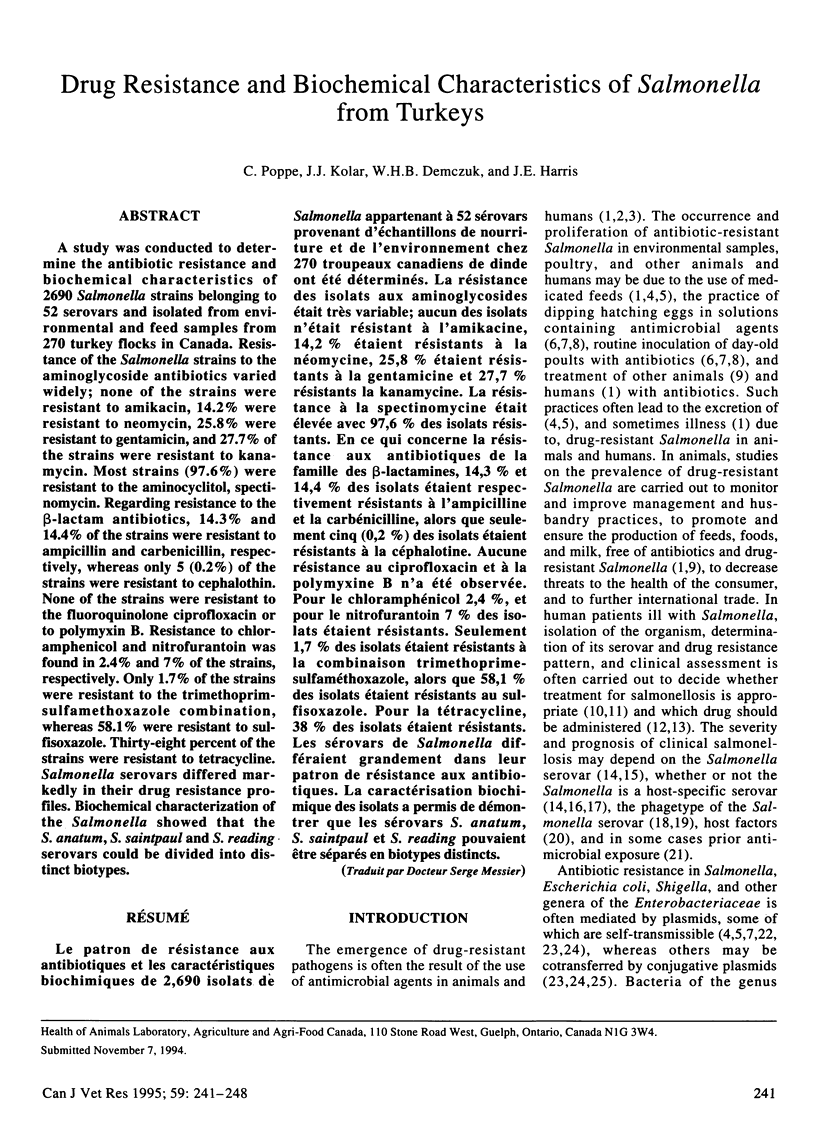
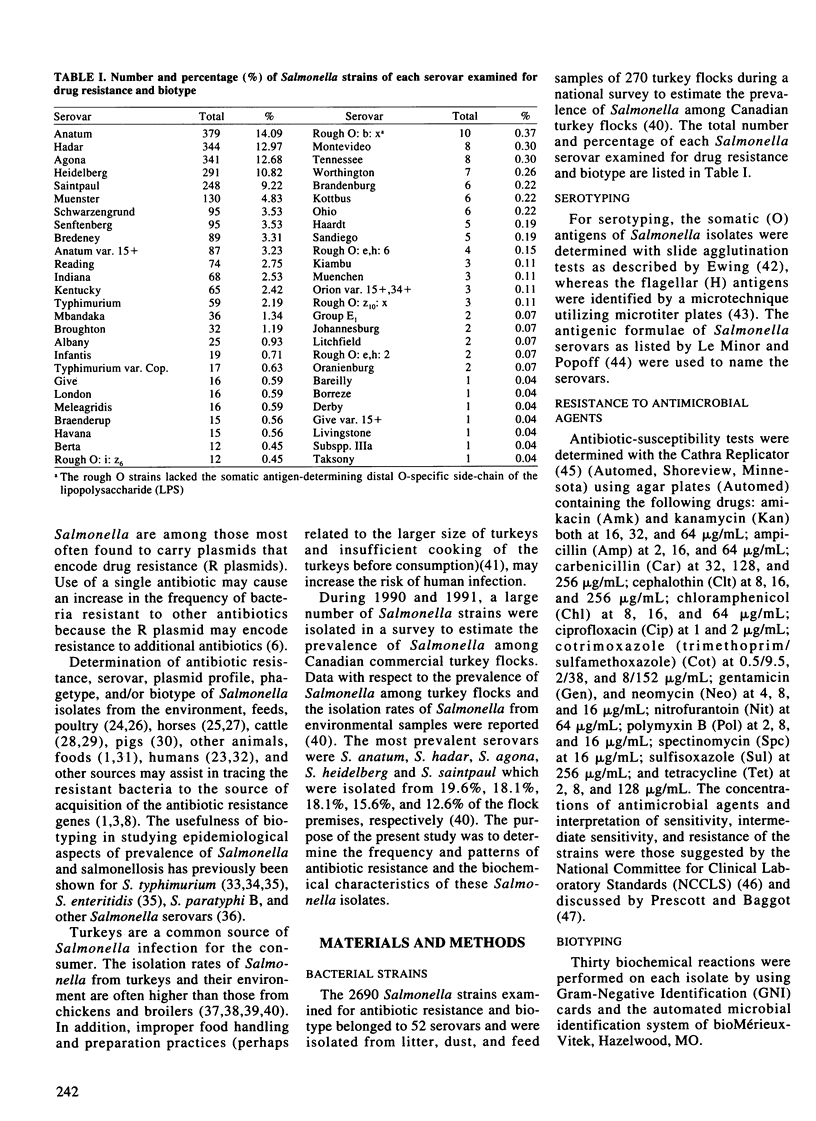
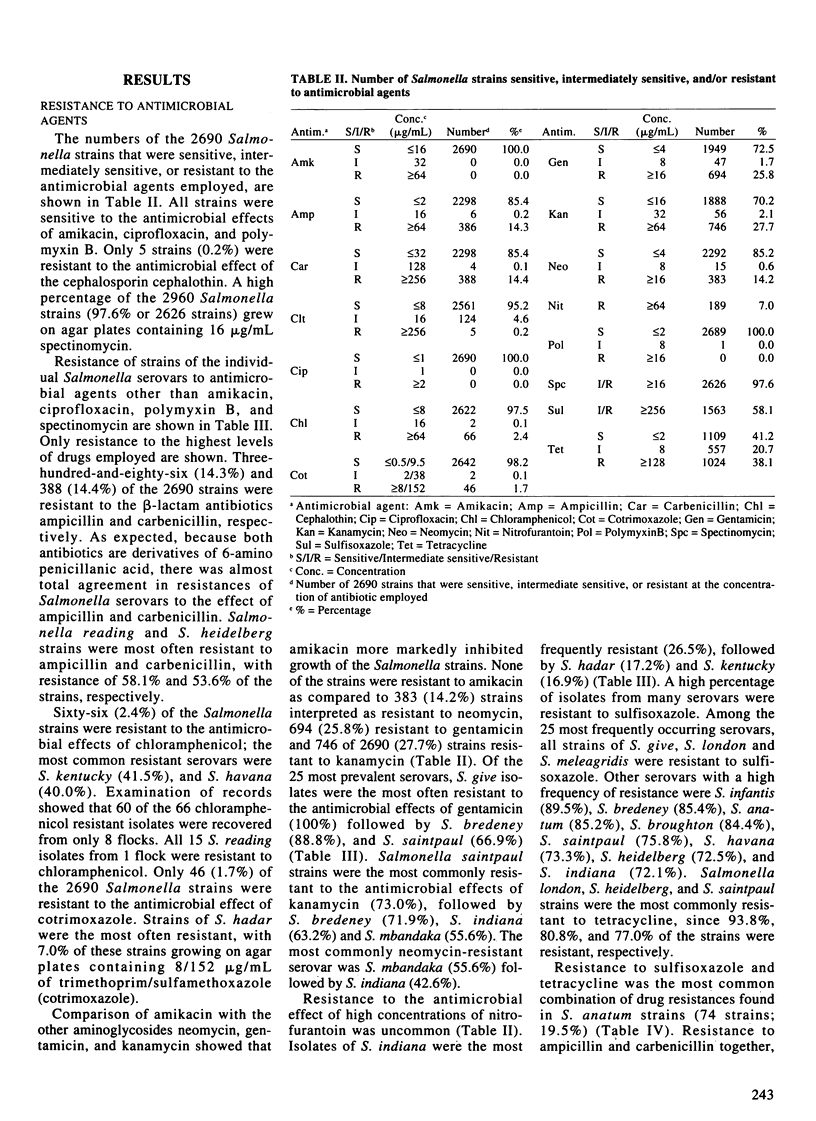
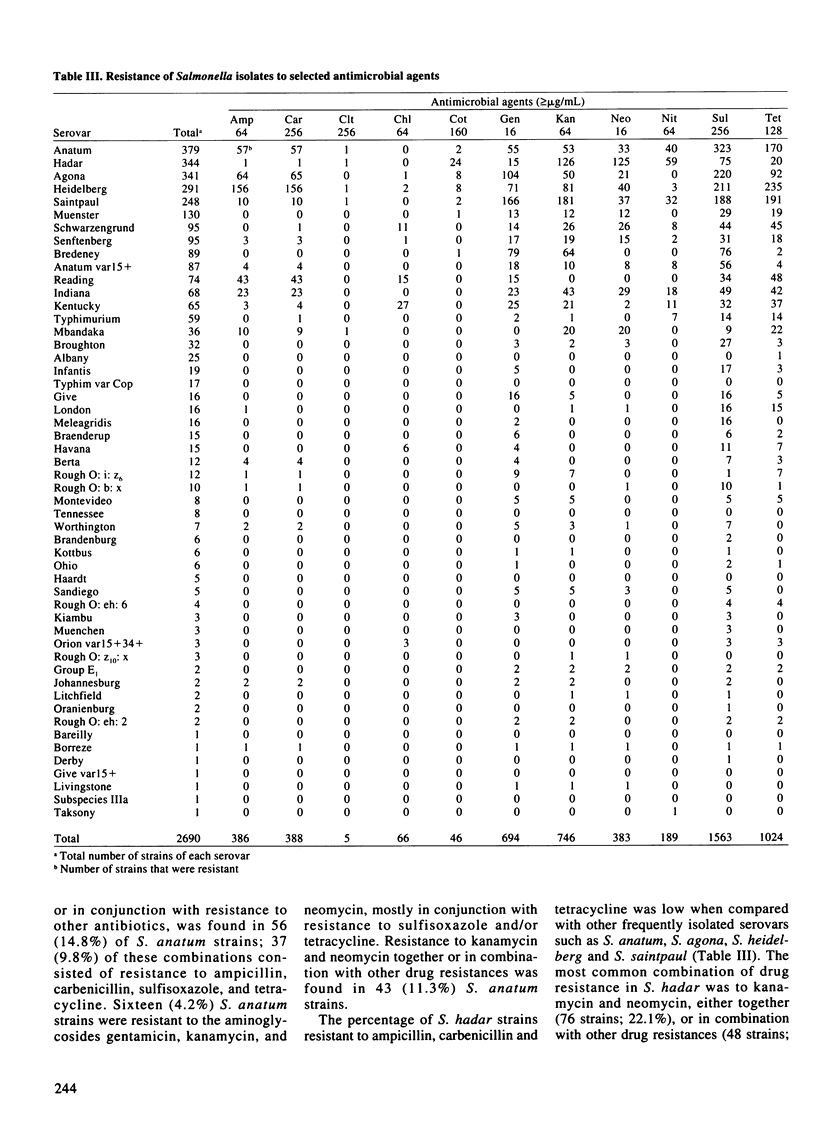
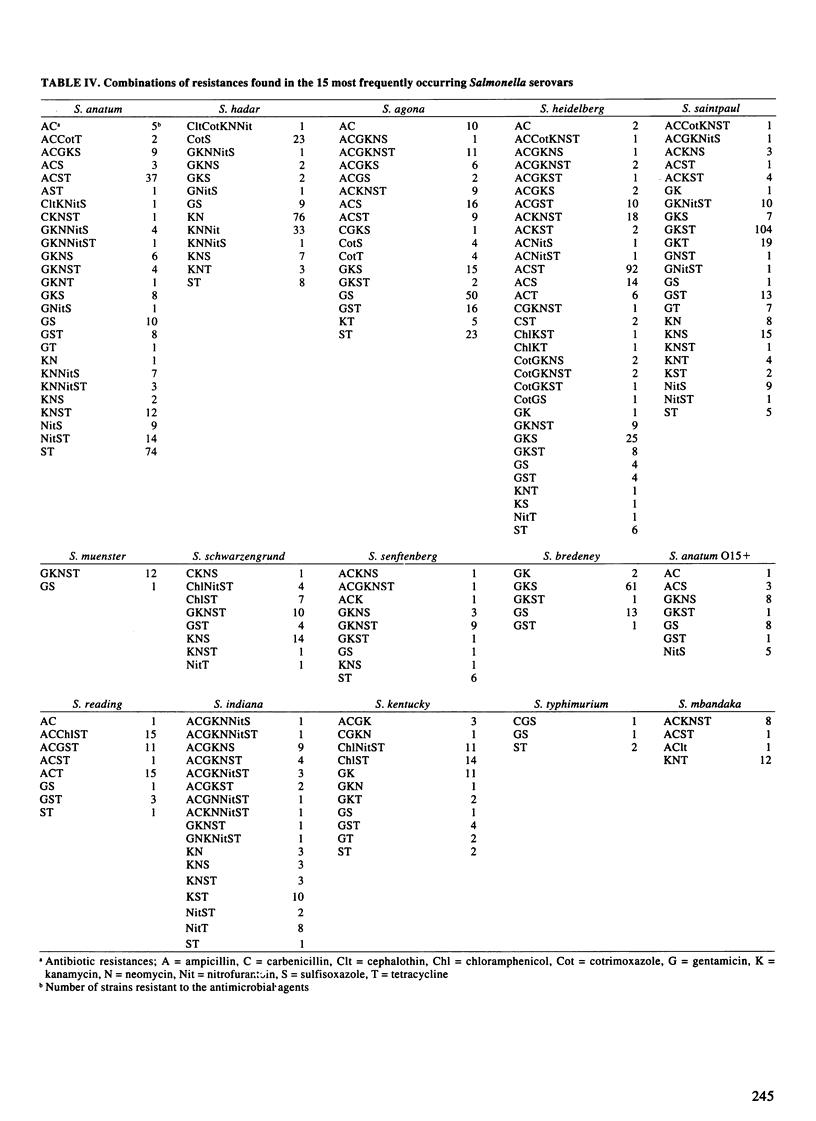

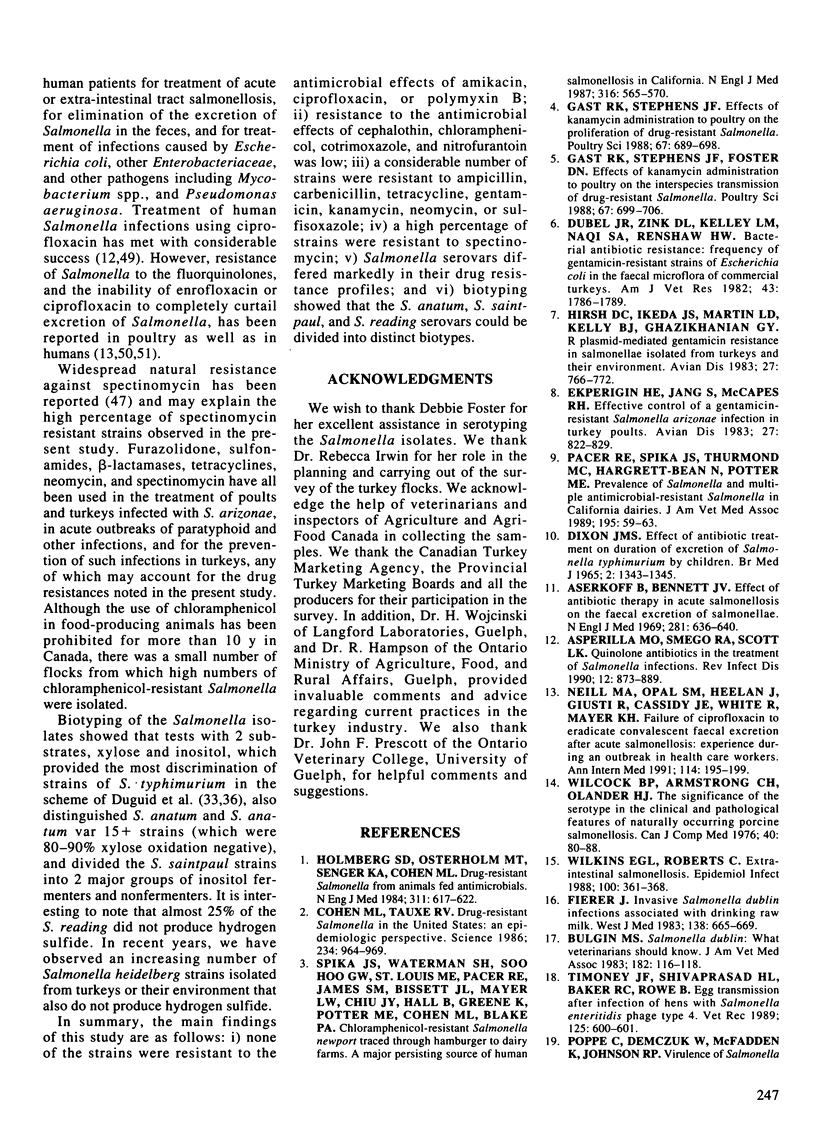
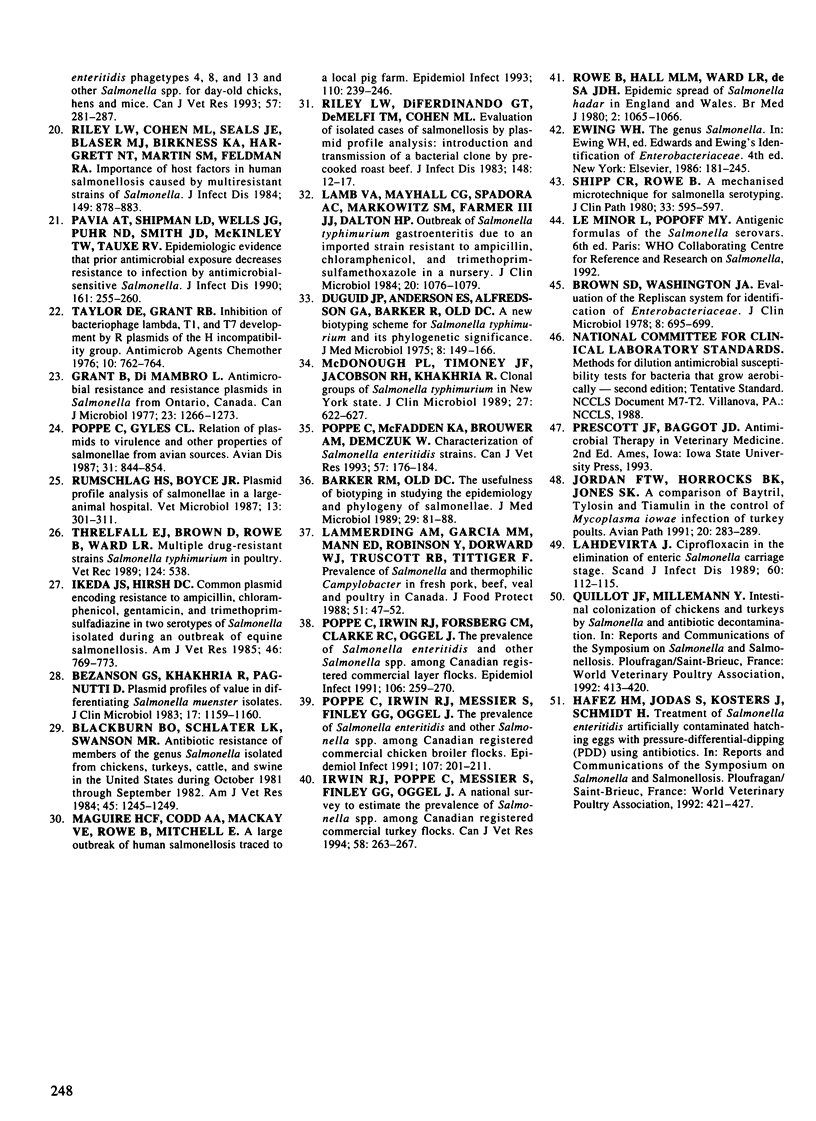
Selected References
These references are in PubMed. This may not be the complete list of references from this article.
- Aserkoff B., Bennett J. V. Effect of antibiotic therapy in acute salmonellosis on the fecal excretion of salmonellae. N Engl J Med. 1969 Sep 18;281(12):636–640. doi: 10.1056/NEJM196909182811202. [DOI] [PubMed] [Google Scholar]
- Asperilla M. O., Smego R. A., Jr, Scott L. K. Quinolone antibiotics in the treatment of Salmonella infections. Rev Infect Dis. 1990 Sep-Oct;12(5):873–889. doi: 10.1093/clinids/12.5.873. [DOI] [PubMed] [Google Scholar]
- Barker R. M., Old D. C. The usefulness of biotyping in studying the epidemiology and phylogeny of salmonellae. J Med Microbiol. 1989 Jun;29(2):81–88. doi: 10.1099/00222615-29-2-81. [DOI] [PubMed] [Google Scholar]
- Bezanson G. S., Khakhria R., Pagnutti D. Plasmid profiles of value in differentiating Salmonella muenster isolates. J Clin Microbiol. 1983 Jun;17(6):1159–1160. doi: 10.1128/jcm.17.6.1159-1160.1983. [DOI] [PMC free article] [PubMed] [Google Scholar]
- Blackburn B. O., Schlater L. K., Swanson M. R. Antibiotic resistance of members of the genus Salmonella isolated from chickens, turkeys, cattle, and swine in the United States during October 1981 through September 1982. Am J Vet Res. 1984 Jun;45(6):1245–1249. [PubMed] [Google Scholar]
- Brown S. D., Washington J. A., 2nd Evaluation of the Repliscan system for identification of Enterobacteriaceae. J Clin Microbiol. 1978 Dec;8(6):695–699. doi: 10.1128/jcm.8.6.695-699.1978. [DOI] [PMC free article] [PubMed] [Google Scholar]
- Bulgin M. S. Salmonella dublin: what veterinarians should know. J Am Vet Med Assoc. 1983 Jan 15;182(2):116–118. [PubMed] [Google Scholar]
- Cohen M. L., Tauxe R. V. Drug-resistant Salmonella in the United States: an epidemiologic perspective. Science. 1986 Nov 21;234(4779):964–969. doi: 10.1126/science.3535069. [DOI] [PubMed] [Google Scholar]
- Dixon J. M. Effect of antibiotic treatment on duration of excretion of Salmonella typhimurium by children. Br Med J. 1965 Dec 4;2(5474):1343–1345. doi: 10.1136/bmj.2.5474.1343. [DOI] [PMC free article] [PubMed] [Google Scholar]
- Dubel J. R., Zink D. L., Kelley L. M., Naqi S. A., Renshaw H. W. Bacterial antibiotic resistance: frequency of gentamicin-resistant strains of Escherichia coli in the fecal microflora of commercial turkeys. Am J Vet Res. 1982 Oct;43(10):1786–1789. [PubMed] [Google Scholar]
- Duguid J. P., Anderson E. S., Alfredsson G. A., Barker R., Old D. C. A new biotyping scheme for Salmonella typhimurium and its phylogenetic significance. J Med Microbiol. 1975 Feb;8(1):149–166. doi: 10.1099/00222615-8-1-149. [DOI] [PubMed] [Google Scholar]
- Ekperigin H. E., Jang S., McCapes R. H. Effective control of a gentamicin-resistant Salmonella arizonae infection in turkey poults. Avian Dis. 1983 Jul-Sep;27(3):822–829. [PubMed] [Google Scholar]
- Fierer J. Invasive Salmonella dublin infections associated with drinking raw milk. West J Med. 1983 May;138(5):665–669. [PMC free article] [PubMed] [Google Scholar]
- Gast R. K., Stephens J. F. Effects of kanamycin administration to poultry on the proliferation of drug-resistant Salmonella. Poult Sci. 1988 May;67(5):689–698. doi: 10.3382/ps.0670689. [DOI] [PubMed] [Google Scholar]
- Gast R. K., Stephens J. F., Foster D. N. Effects of kanamycin administration to poultry on the interspecies transmission of drug-resistant Salmonella. Poult Sci. 1988 May;67(5):699–706. doi: 10.3382/ps.0670699. [DOI] [PubMed] [Google Scholar]
- Grant R. B., Di Mambro L. Antimicrobial resistance and resistance plasmids in Salmonella from Ontario, Canada. Can J Microbiol. 1977 Sep;23(9):1266–1273. doi: 10.1139/m77-190. [DOI] [PubMed] [Google Scholar]
- Hirsh D. C., Ikeda J. S., Martin L. D., Kelly B. J., Ghazikhanian G. Y. R plasmid-mediated gentamicin resistance in salmonellae isolated from turkeys and their environment. Avian Dis. 1983 Jul-Sep;27(3):766–772. [PubMed] [Google Scholar]
- Holmberg S. D., Osterholm M. T., Senger K. A., Cohen M. L. Drug-resistant Salmonella from animals fed antimicrobials. N Engl J Med. 1984 Sep 6;311(10):617–622. doi: 10.1056/NEJM198409063111001. [DOI] [PubMed] [Google Scholar]
- Ikeda J. S., Hirsh D. C. Common plasmid encoding resistance to ampicillin, chloramphenicol, gentamicin, and trimethoprim-sulfadiazine in two serotypes of Salmonella isolated during an outbreak of equine salmonellosis. Am J Vet Res. 1985 Apr;46(4):769–773. [PubMed] [Google Scholar]
- Irwin R. J., Poppe C., Messier S., Finley G. G., Oggel J. A national survey to estimate the prevalence of Salmonella species among Canadian registered commercial turkey flocks. Can J Vet Res. 1994 Oct;58(4):263–267. [PMC free article] [PubMed] [Google Scholar]
- Lamb V. A., Mayhall C. G., Spadora A. C., Markowitz S. M., Farmer J. J., 3rd, Dalton H. P. Outbreak of Salmonella typhimurium gastroenteritis due to an imported strain resistant to ampicillin, chloramphenicol, and trimethoprim-sulfamethoxazole in a nursery. J Clin Microbiol. 1984 Dec;20(6):1076–1079. doi: 10.1128/jcm.20.6.1076-1079.1984. [DOI] [PMC free article] [PubMed] [Google Scholar]
- Lähdevirta J. Ciprofloxacin in the elimination of enteric Salmonella carriage stage. Scand J Infect Dis Suppl. 1989;60:112–115. [PubMed] [Google Scholar]
- Maguire H. C., Codd A. A., Mackay V. E., Rowe B., Mitchell E. A large outbreak of human salmonellosis traced to a local pig farm. Epidemiol Infect. 1993 Apr;110(2):239–246. doi: 10.1017/s0950268800068151. [DOI] [PMC free article] [PubMed] [Google Scholar]
- McDonough P. L., Timoney J. F., Jacobson R. H., Khakhria R. Clonal groups of Salmonella typhimurium in New York State. J Clin Microbiol. 1989 Apr;27(4):622–627. doi: 10.1128/jcm.27.4.622-627.1989. [DOI] [PMC free article] [PubMed] [Google Scholar]
- Neill M. A., Opal S. M., Heelan J., Giusti R., Cassidy J. E., White R., Mayer K. H. Failure of ciprofloxacin to eradicate convalescent fecal excretion after acute salmonellosis: experience during an outbreak in health care workers. Ann Intern Med. 1991 Feb 1;114(3):195–199. doi: 10.7326/0003-4819-114-3-195. [DOI] [PubMed] [Google Scholar]
- Pacer R. E., Spika J. S., Thurmond M. C., Hargrett-Bean N., Potter M. E. Prevalence of Salmonella and multiple antimicrobial-resistant Salmonella in California dairies. J Am Vet Med Assoc. 1989 Jul 1;195(1):59–63. [PubMed] [Google Scholar]
- Pavia A. T., Shipman L. D., Wells J. G., Puhr N. D., Smith J. D., McKinley T. W., Tauxe R. V. Epidemiologic evidence that prior antimicrobial exposure decreases resistance to infection by antimicrobial-sensitive Salmonella. J Infect Dis. 1990 Feb;161(2):255–260. doi: 10.1093/infdis/161.2.255. [DOI] [PubMed] [Google Scholar]
- Poppe C., Gyles C. L. Relation of plasmids to virulence and other properties of salmonellae from avian sources. Avian Dis. 1987 Oct-Dec;31(4):844–854. [PubMed] [Google Scholar]
- Poppe C., Irwin R. J., Forsberg C. M., Clarke R. C., Oggel J. The prevalence of Salmonella enteritidis and other Salmonella spp. among Canadian registered commercial layer flocks. Epidemiol Infect. 1991 Apr;106(2):259–270. doi: 10.1017/s0950268800048408. [DOI] [PMC free article] [PubMed] [Google Scholar]
- Poppe C., Irwin R. J., Messier S., Finley G. G., Oggel J. The prevalence of Salmonella enteritidis and other Salmonella sp. among Canadian registered commercial chicken broiler flocks. Epidemiol Infect. 1991 Aug;107(1):201–211. doi: 10.1017/s0950268800048822. [DOI] [PMC free article] [PubMed] [Google Scholar]
- Poppe C., McFadden K. A., Brouwer A. M., Demczuk W. Characterization of Salmonella enteritidis strains. Can J Vet Res. 1993 Jul;57(3):176–184. [PMC free article] [PubMed] [Google Scholar]
- Riley L. W., Cohen M. L., Seals J. E., Blaser M. J., Birkness K. A., Hargrett N. T., Martin S. M., Feldman R. A. Importance of host factors in human salmonellosis caused by multiresistant strains of Salmonella. J Infect Dis. 1984 Jun;149(6):878–883. doi: 10.1093/infdis/149.6.878. [DOI] [PubMed] [Google Scholar]
- Riley L. W., DiFerdinando G. T., Jr, DeMelfi T. M., Cohen M. L. Evaluation of isolated cases of salmonellosis by plasmid profile analysis: introduction and transmission of a bacterial clone by precooked roast beef. J Infect Dis. 1983 Jul;148(1):12–17. doi: 10.1093/infdis/148.1.12. [DOI] [PubMed] [Google Scholar]
- Rowe B., Hall M. L., Ward L. R., de Sa J. D. Epidemic spread of Salmonella hadar in England and Wales. Br Med J. 1980 Apr 19;280(6221):1065–1066. doi: 10.1136/bmj.280.6221.1065. [DOI] [PMC free article] [PubMed] [Google Scholar]
- Rumschlag H. S., Boyce J. R. Plasmid profile analysis of salmonellae in a large-animal hospital. Vet Microbiol. 1987 Apr;13(4):301–311. doi: 10.1016/0378-1135(87)90061-7. [DOI] [PubMed] [Google Scholar]
- Shipp C. R., Rowe B. A mechanised microtechnique for salmonella serotyping. J Clin Pathol. 1980 Jun;33(6):595–597. doi: 10.1136/jcp.33.6.595. [DOI] [PMC free article] [PubMed] [Google Scholar]
- Spika J. S., Waterman S. H., Hoo G. W., St Louis M. E., Pacer R. E., James S. M., Bissett M. L., Mayer L. W., Chiu J. Y., Hall B. Chloramphenicol-resistant Salmonella newport traced through hamburger to dairy farms. A major persisting source of human salmonellosis in California. N Engl J Med. 1987 Mar 5;316(10):565–570. doi: 10.1056/NEJM198703053161001. [DOI] [PubMed] [Google Scholar]
- Taylor D. E., Grant R. B. Inhibition of bacteriophage lambda, T1, and T7 development by R plasmids of the H incompatibility group. Antimicrob Agents Chemother. 1976 Oct;10(4):762–764. doi: 10.1128/aac.10.4.762. [DOI] [PMC free article] [PubMed] [Google Scholar]
- Threlfall E. J., Brown D., Rowe B., Ward L. R. Multiple drug-resistant strains of Salmonella typhimurium in poultry. Vet Rec. 1989 May 20;124(20):538–538. doi: 10.1136/vr.124.20.538-a. [DOI] [PubMed] [Google Scholar]
- Timoney J. F., Shivaprasad H. L., Baker R. C., Rowe B. Egg transmission after infection of hens with Salmonella enteritidis phage type 4. Vet Rec. 1989 Dec 9;125(24):600–601. [PubMed] [Google Scholar]
- Wilcock B. P., Armstrong C. H., Olander H. J. The significance of the serotype in the clinical and pathological features of naturally occurring porcine salmonellosis. Can J Comp Med. 1976 Jan;40(1):80–88. [PMC free article] [PubMed] [Google Scholar]
- Wilkins E. G., Roberts C. Extraintestinal salmonellosis. Epidemiol Infect. 1988 Jun;100(3):361–368. doi: 10.1017/s095026880006711x. [DOI] [PMC free article] [PubMed] [Google Scholar]


